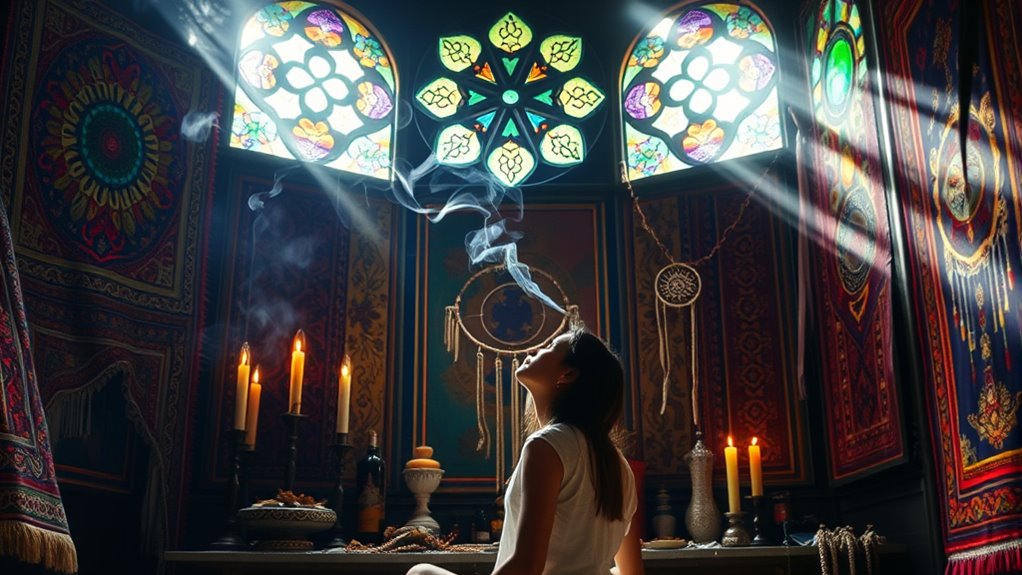Many spiritual traditions see dreams as messages from divine beings, ancestors, or your subconscious, offering guidance and insight. For example, indigenous cultures often interpret dreams as sacred communications, while in Buddhism and Hinduism, they’re viewed as windows into spiritual growth. Meditation and dream journaling help deepen your understanding of these messages. By recognizing symbols and patterns, you can unseal profound truths about your inner self and spiritual path—continue exploring to uncover more hidden meanings.
Key Takeaways
- Many cultures see dreams as messages from divine beings, ancestors, or spiritual guides conveying important insights.
- Indigenous and shamanic traditions use dreams for spiritual guidance, healing, and connecting with higher realms.
- In Christianity, dreams are often viewed as communication from God or angels, offering divine wisdom or warnings.
- Eastern philosophies like Buddhism and Hinduism interpret dreams as reflections of karma, consciousness, or spiritual progress.
- Indigenous and ancient societies frequently kept dream journals and used meditation to deepen their understanding of dream messages.

Dreams have long been considered a bridge between the conscious and spiritual worlds, offering insights beyond everyday understanding. When you pay attention to your dreams, you tap into a domain where symbols and messages often carry deeper meanings. This is where dream symbolism comes into play—analyzing the images, actions, and emotions within your dreams can reveal truths about your inner self and spiritual path. Many traditions believe that dreams aren’t just random images but meaningful messages from a higher power, ancestors, or your subconscious mind. By honing your ability to interpret these symbols, you can unlock guidance that helps you navigate life’s challenges with more clarity and purpose.
Dreams connect the conscious and spiritual worlds, revealing hidden truths through symbols and messages from higher realms.
Meditation practices are often integrated into the process of understanding dreams, especially within spiritual traditions that emphasize mindfulness and inner awareness. When you meditate, you quiet your mind and create a receptive space for your subconscious to communicate with you. This quietude allows dream symbols to surface more vividly, making it easier to interpret their significance. Many spiritual practices suggest that before sleeping, you set an intention to receive guidance or insight through your dreams, and meditation helps reinforce this intention. By consistently practicing meditation, you strengthen your connection to your inner self, creating a fertile ground for meaningful dream experiences.
In various spiritual traditions, dream symbolism isn’t just passively observed but actively explored through meditation and reflection. For example, some cultures believe that recurring dreams or vivid symbols are signs or messages from divine beings or ancestors trying to communicate important truths. You might keep a dream journal, recording images and feelings upon waking, and then use meditation to explore more deeply into their meanings. This process can help you recognize patterns and symbols that point to your spiritual growth or unresolved issues. Over time, this practice cultivates intuition and a greater understanding of your spiritual journey.
Integrating meditation practices into your routine not only enhances your ability to interpret dream symbolism but also deepens your overall spiritual awareness. It encourages you to approach dreams with curiosity and reverence, seeing them as sacred messages rather than random images. When you view dreams through this lens, you begin to trust your inner guidance more, fostering a sense of connection with the divine or your higher self. The harmony between meditation and dream interpretation becomes a powerful tool for spiritual development, allowing you to access wisdom that transcends the physical realm and supports your evolution on a soul level. Additionally, understanding the symbolic language of dreams can deepen your appreciation for the holistic nature of your inner and outer worlds.
Frequently Asked Questions
How Do Different Cultures Interpret Prophetic Dreams?
You see, different cultures interpret prophetic dreams through ancient dream and cultural symbolism. For example, some look for signs or messages from ancestors, believing dreams reveal future events or guidance. Others see them as divine communication, with symbols representing spiritual truths. By understanding these ancient dreams and their cultural symbolism, you can better grasp how diverse traditions view prophetic dreams as meaningful, spiritual insights rather than random thoughts.
Can Dreams Reveal Future Spiritual Insights?
Dreams can serve as windows to future spiritual insights, guiding you through the maze of your inner world. By exploring dream symbolism, you may uncover hidden messages that spark your spiritual awakening. While not guaranteed, these visions often reflect your soul’s whispers, revealing paths you’re destined to take. Trust your intuition, and embrace dreams as sacred clues that can illuminate your journey toward spiritual growth and enlightenment.
What Role Do Dreams Play in Religious Rituals?
In religious rituals, dreams often play a crucial role by serving as messages from the divine, guided by dream symbolism. You might interpret dreams during spiritual practices to gain insight, foster spiritual awakening, or connect with higher powers. Many traditions believe that paying attention to dreams can reveal hidden truths, inspire faith, and deepen your spiritual journey. By actively engaging with your dreams, you can access divine guidance and enhance your spiritual growth.
Are There Specific Symbols in Dreams Unique to Spirituality?
You see that certain dream symbols hold unique spiritual meanings across traditions. For example, a lotus often signifies purity and enlightenment, while a serpent can represent transformation or spiritual awakening. These dream symbols are more than just images; they carry deep spiritual messages. When you interpret your dreams, pay attention to these symbols, as they can reveal insights about your spiritual journey and personal growth.
How Can I Interpret My Dreams Spiritually?
Imagine your dreams as a lighthouse guiding you through foggy waters. To interpret them spiritually, pay attention to dream symbolism—colors, objects, and actions that hold personal or universal meanings. Reflect on how these symbols relate to your life and spiritual awakening. Trust your intuition, journal your dreams, and consider seeking guidance from spiritual texts or mentors to deepen your understanding and foster growth.
Conclusion
As you explore how different traditions view dreams, you realize they’re like mysterious keys revealing ancient wisdom and spiritual insights. Whether seen as messages from the divine or gateways to your subconscious, dreams invite you to connect with a deeper part of yourself. Embracing these visions can be as enlightening as finding a hidden treasure map—guiding you toward greater understanding and inner peace on your spiritual journey.









